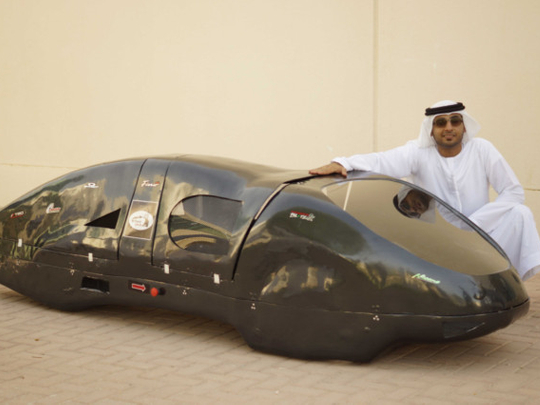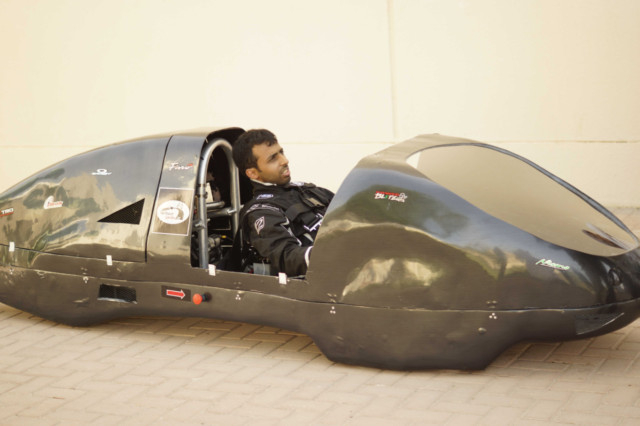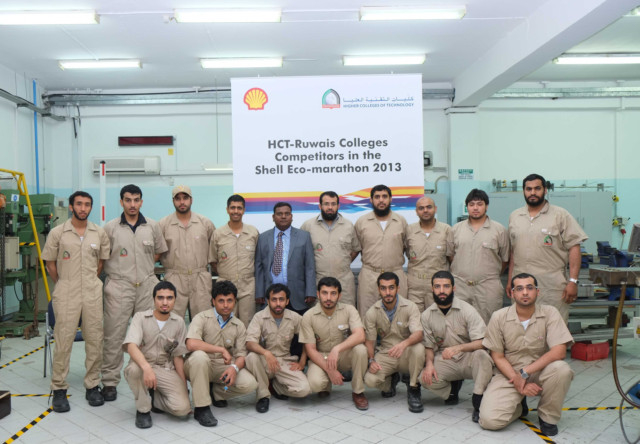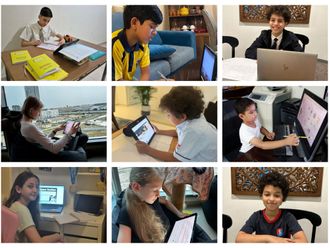
The world needs fuel-efficient cars. No argument there. Every effort made to design one is a reason to cheer.
In that context, the participation of five UAE universities - American University in Dubai, the American University of Sharjah, HCT’s Abu Dhabi Men’s College, HCT’s Dubai Men’s College and HCT’s Ruwais Colleges - in this year’s edition of the Shell Eco-marathon race, a global vehicle race composed of teams of university students from around the world who design, build and test energy-efficient vehicles, with the challenge to reach the furthest distance using the least amount of energy, is a great leap forward.
This year, a total of seven UAE teams will race with their “Made in the UAE” fuel-efficient cars, a 7-fold increase over the last year. The awareness raised by the 2012 single entry by HCT’s Abu Dhabi Men’s College, who raced with the first “Made in the UAE” fuel-efficient car, encouraged other colleges to participate in the Shell Eco-marathon campaign this year.
Questions
Abdulazeez Al Mehairi, a mechatronics student and Team Manager of the ‘Without Limits’ car at HCT’s Ruwais Colleges, whose Eco-marathon team is comprises 17 students in the final years of their mechatronics bachelor’s degrees, talks of his design and his outlook on how to make the planet more fuel-efficient.
Do you feel fuel-efficient cars are necessary in this day and age?
Definitely, fuel-efficient cars are necessary. At the moment, many of us Emiratis, are becoming increasingly aware of the issue of fuel-efficiency in cars.
Air pollution increases everyday around the world and cars are now one of the main causes of this problem because of the carbon dioxide produced by their engines. The higher the CO2 production, the more it affects us and our environment.
If we, as a country, decide to use more fuel-efficient cars, it will help us move faster towards cleaner energy and support other initiatives in the UAE that are focusing on green energy just like solar and other clean electricity generation solutions.
We are already seeing challenges with our environment and the effects are increasing quicker than ever. Through fuel-efficient cars, i.e. less consumption of energy and less pollution, we can save our environment and our community. As national students, it is a great opportunity for us to take part in projects that will improve our future. I feel it is everyone’s responsibility to contribute to finding different ways to keep the world safe and sustainable.
What is your understanding of the global energy issues and the best ways to remedy them?
As developed countries around the world reach or have reached their industrial peak, they have a good understanding of the impact of their activities on the global environment. Unfortunately, this means that many countries have missed opportunities to develop and use clean energy solutions, which has caused many problems to their environments. This is why we must learn from mistakes made in other parts of the world and lead the way to cleaner energy.
Luckily, as a young and high-tech country, we understand that clean energy is our future. This is why the UAE is building the right infrastructure and programs to keep the industrial impact to a minimum.
It would be great if individuals can be educated on the impact they have on the environment on a daily basis and how to act responsibly and also have countries start to fully adopt clean energy.
What have been the main operating principles for challenge of designing a fuel-efficient car?
Simplicity was our guiding principle. We were all able to agree that the simpler the car design was, the faster and easier it will be for us to troubleshoot and maintain the car.
Besides the simplicity of our car shape, we modified the engine we sourced from Germany and simplified its wiring circuits. We were able to completely change its pre-packaged and complicated wiring design and successfully reduce the number of its wires to about three or four.
This approach will ensure that we can quickly identify and correct any error that might come our way. The simpler the build, the simpler the solutions. We hope that this strategy will increase our chances of succeeding on the day of the Shell Eco-marathon event.
What experience and skills have you gained from such an exercise?
We all gained a lot from this experience. At first, it was a great challenge for me and my team, as we have never participated in a global competition before, yet we still managed to build a car with our own hands. We all signed up to Shell Eco-marathon to improve our engineering abilities by putting into practice what we learned from our studies and pushing our knowledge and creativity to its limits.
As the team manager, this opportunity allowed me to understand the unique strengths of each team member and push the team to deliver on our goals. I hope that I did my best in bringing out everyone’s strength and provided opportunities that helped people build on their capabilities.
We were blessed that everyone on the team was 100% committed to this project, so we have a great sense of cooperation and being all Emiratis on the team, we were all working towards carrying the UAE flag to the race.
If you ask any team member, they would agree that we learned a lot about teamwork and perseverance. No matter what the end result will be in the Kuala Lumpur race, we feel fulfilled that we have gained a very good experience out of this project.
What have been the most challenging aspects of designing a fuel-efficient car?
Tuning the engine was very important, we had to build the car with optimum consumption of fuel in relation to the engine’s torque in order to gain maximum efficiency. This meant that we had to get the most amount of power at the least amount of RPM during the testing of our car.
As we are all part-time students working during the day and studying in the evening, timing was a challenge. We organised ourselves into four groups of four, each team responsible for an aspect of the project, with me as Team Manager.
One group was responsible for the powertrain, the second for steering and breaks, the third for electrical and instrumentations, while the fourth group managed the body and frame. Each group had its own leader that distributed tasks to his team members. Through this process, we were able to organise our time well.
Also since we are in the western region of the UAE, sourcing parts and finding specialised tools was tough. We ordered some parts online and the rest we had to build from scratch, which was challenging. We really feel that we built the car with our own hands.
Shell had very strict guidelines on the safety aspect of the car, so we paid extra attention to stick to them, as we do not want to risk anything relating to the safety of our people or anyone else on race day.
We also had to consider how we would get our vehicle to Kuala Lumpur. Shell supported us with an initial investment, which enabled us to get to a stage where we could present to the CEOs of Borouge and Emirates Nuclear Energy Company (ENEC). It was great to see how energetic the CEOs were to support our project.
There were as many fun moments as challenges. I recall the day we were building the outer body and we got covered with foam and looked like Santa Clauses. We had such a good laugh that day!
What would you say was the division of your time between implementing innovations to your vehicle versus pure engineering?
Many of the traditional engineering methods had to be customised for the needs of our build. This is where innovation was important. As a team we came up with a lot of new ideas to make sure that we got the most out of the common techniques used in engineering.
The division of our time between basic engineering and innovation varied between each aspect of the build. To manage our time well, every time we faced an issue, we made sure that we solved it within one or two days maximum.
Would you drive your own design of fuel-efficient car as your way to help the environment?
Yes, I hope that our car could go to market some day.
As we built the car, we kept in our vision a final product that will help reduce air pollution in the UAE. We tried as much as possible to minimise outsourcing and use materials that are available in the local market or build parts from scratch. It feels amazing that we, as Emirati students, can produce a machine that can travel thousands of kilometres on a single litre of fuel.
I hope that all the UAE participating cars at the Shell Eco-marathon are proof that our country has the capability to produce advanced technologies. I hope that in the near future, the UAE will become one of the countries that are well known for exporting technologies to help other countries with their energy issues.
What are your suggestions for diffusing the energy crisis?
It is time for individuals to take the energy crisis seriously. We need to be more aware of the way we drive so that we use less fuel and create less pollution. If we do this, we can help safeguard our communities.
Another way to improve the situation is to encourage the younger generation to find solutions. I have come across case studies where large companies in the US go to universities and provide engineering students with real-life problems, allowing them to participate in bringing new solutions to the table.
Companies that want to make a big difference in our world can use these student-created energy solutions. I am thankful that as a student, I have the chance to be a member of a wider student group that is working to tackle the global energy crisis. In the meantime, we are starting to do our part with our participation in the Shell Eco-marathon race.
The team has set its sights on Manila 2014 after the Shell Eco-marathon in Malaysia this year was cancelled due to haze.













